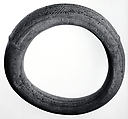Yoke
Not on view
Stone elliptical collars are most likely part of an assemblage of works that served as regalia that affirmed and projected political power, used in public and restricted ceremonial activities. One such public ceremony may have been a ballgame played with rubber balls, such as was described by Spanish chroniclers in both the Antilles and the Mesoamerican mainland. The collars may contain abstracted or pars-pro-toto representations of zemí figures, featured in Taíno mythology. Zemí (or cemí) is a term used by Taíno peoples, the diverse societies that inhabited the Antilles archipelago before European contact, that linguistically relates to a quality akin to sweetness. Zemí refers not to an object or image but to an immaterial, spiritual, and vital force pertaining to deities and ancestors. There are several known zemí identities recorded by the Spanish, some of which have been linked to archaeological images.
It is notable that none of the stone collars were reportedly found with funerary remains, suggesting that these potent works of sculpture were inherited by the descendants of the original caretaker, rather than being buried with the deceased.
This image cannot be enlarged, viewed at full screen, or downloaded.

